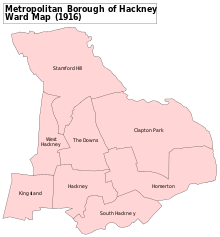Hackney, London
.jpg)
Hackney is a major district in inner London, forming around two thirds of the area of the modern London Borough to which it gives its name.
In the past it was also referred to as Hackney Proper, to distinguish it from the village which subsequently developed in the vicinity of Mare Street. The term Hackney Proper being applied to that wider district[1]
Districts
Hackney includes the sub-districts of Upper and Lower Clapton, Dalston, De Beauvoir Town, Hackney Central, Hackney Wick, Homerton, South Hackney, Stamford Hill and West Hackney.
Administration

Hackney was an administrative unit with consistent boundaries from the early middle ages to the creation of the larger modern borough in 1965. Hackney was based for many centuries on the Ancient Parish of Hackney
Parishes in Middlesex were grouped into ‘Divisions’, with Hackney part of the Tower Division (aka Tower Hamlets). The Tower Division was noteworthy in that the men of the area owed military service to the Tower of London.[2]
The Ancient Parishes provided a framework for both civil (administrative) and ecclesiastical (church) functions, but during the nineteenth century there was a divergence into distinct civil and ecclesiastical parish systems. In London the Ecclesiastical Parishes sub-divided to better serve the needs of a growing population, while the Civil Parishes continued to be based on the same Ancient Parish areas.
The Metropolis Management Act 1855 merged the Civil Parishes of Hackney and Stoke Newington under a new Hackney District. This proved very unpopular, especially in more affluent Stoke Newington and after four unsuccessful attempts the two parishes regained their independence when they were separated by mutual consent under the Metropolis Management (Plumstead and Hackney) Act of 1893.[3]
The London Government Act 1899 converted the parishes into Metropolitan Boroughs based on the same boundaries, sometimes with minor rationalisations. In 1965, Hackney merged with Shoreditch and Stoke Newington to form the new London Borough of Hackney.

Open spaces
Open spaces in Hackney include:
- Clapton Common[4]
- Hackney Downs
- Hackney Marshes
- London Fields
- Queen Elizabeth Olympic Park (part)
- Springfield Park and Spring Hill Recreation Ground
- Victoria Park (part)
References
- ↑ "The National Gazetteer of Great Britain and Ireland". 1868. Retrieved 20 February 2007.
- ↑ The London Encyclopaedia, 4th Edition, 1983, Weinreb and Hibbert
- ↑ "Stoke Newington: Local government | British History Online". www.british-history.ac.uk. Retrieved 7 October 2018.
- ↑ Clapton Common 30 June 2009 (Planning Inspectorate Casework) accessed 19 Sept 2009